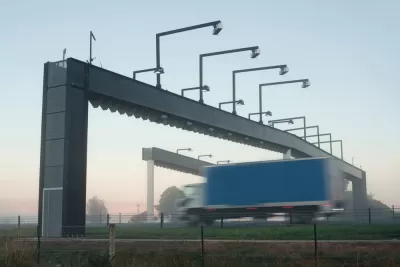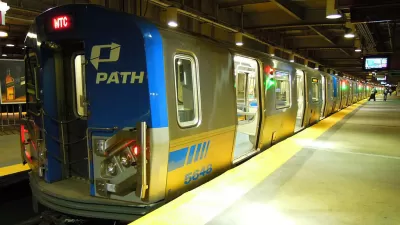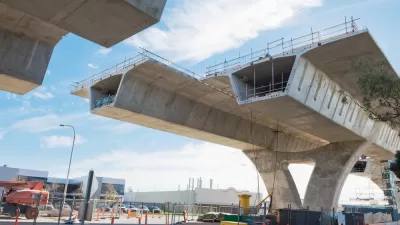While there has been no lack of criticism (some might say condemnation) of the $200 billion investment that aims to generate an additional $1.3 trillion, some individuals and groups have stepped forward to praise the plan, or at least parts of it.

Trump's plan, unveiled Monday, must first be approved by Congress. "The immediate consensus is that the plan is dead on arrival* because it is unreasonable to expect any entity outside of the federal government to absorb such a large portion of the cost," writes the editorial staff of DC Velocity, a magazine that serves the logistics industry, in an introduction to a column by Robert W. Poole Jr., director of transportation policy for the Reason Foundation, a libertarian think tank.
That is the thinking of House Democrats, which have already proposed an infrastructure initiative using $1 trillion of direct federal spending.
Poole ... believes the Trump plan is on solid ground, and with some innovative thinking can be executed without tax increases or massive additional borrowing.
Poole attempts to rebut some of the widespread criticism of the plan. Referring to the $100 billion "Incentives Program" (see White House fact sheet), he defends the funding ratio. The "historic 80/20 federal/state funding split" remains unchanged, he writes.
The "Incentives Initiative" is in addition to those long-standing programs, and it's intended to draw on innovative financing in an effort to leverage the federal dollars. To make good on that premise, the White House plan would significantly expand [by $20 billion] the federal programs that assist such leveraging: Private activity bonds, TIFIA, RRIF, and WIFIA.
However, the critical $12.7 billion project to rebuild the Amtrak's Hudson River rail tunnels, which hoped to use Rail Rehabilitation & Improvement Financing (RRIF), appears on shaky ground precisely due to this funding mechanism. Chicago's Union Station also hoped to use RRIF.
Rather than a stimulus program like President Obama's American Recovery and Reinvestment Act of 2009, "[w]hat we do need is much better targeting of investment to infrastructure projects that deliver better value for money," adds Poole. "Both the Incentives Initiative and the 'Transformative Projects Program' are aimed at this kind of project."
According to the White House, the $20 billion Transformative Projects Program "will focus on projects that could have a significant positive impact on States, cities, and localities but may not attract private sector investment because of the project’s unique characteristics."
However, it is the incentives for private investment and the permit streamlining that drew praise from a powerful northern California business group, report Michael Cabanatuan and Kurtis Alexander for the San Francisco Chronicle on Feb. 12.
The Bay Area Council, which advocates for the region’s business community, said it was encouraged that Trump was “making good on his promise to address this country’s badly deteriorating infrastructure.” The group applauded the idea of public-private partnerships and the potential for removing regulations — two aspects of the proposal that drew strong criticism from Democrats and environmentalists.
Well, not all Democrats. When asked by the PBS Newshour's Judy Woodruff on Monday if "it’s a good thing that they’re talking about streamlining, cutting back on some of the federal regulations," Mayor Eric Garcetti of Los Angeles, a Democrat, replied:
Absolutely.
Any day we cut red tape is also music to the ears of America’s mayors. And so I think that’s a great part of this proposal, if it actually bears out. But we do need to have money to match that.
The praise was reciprocated earlier, reported Laura King for the Los Angeles Times on Feb. 11.
A senior administration official, speaking in advance of Monday's release of the White House's "infrastructure principles," singled out for praise a Los Angeles County sales-tax increase that was a top initiative of Mayor Eric Garcetti.
"When we're thinking of revenues at the state and local level… a good case study would be Measure M in Los Angeles," the administration official said, noting approvingly that the ballot-approved tax increase is "the ultimate sustainable source of revenue for projects."
Correspondent's notes:
- Poole's column can also be found as the first article in Reason's Surface Transportation News #172.
- *As for the project being "dead on arrival," Julie Hirschfeld Davis of The New York Times reported Feb. 11 that the plan "faces long odds on Capitol Hill, where members of both parties — particularly Democrats — are skeptical of any plan that fails to create a dedicated new funding stream to address the nation’s crumbling infrastructure."
- In addition to the White House fact sheet on the plan, see the U.S. Department of Transportation's 5-page highlights [pdf] and the 55-page plan [pdf] itself.
FULL STORY: In praise of Trump's infrastructure plan

Maui's Vacation Rental Debate Turns Ugly
Verbal attacks, misinformation campaigns and fistfights plague a high-stakes debate to convert thousands of vacation rentals into long-term housing.

Planetizen Federal Action Tracker
A weekly monitor of how Trump’s orders and actions are impacting planners and planning in America.

In Urban Planning, AI Prompting Could be the New Design Thinking
Creativity has long been key to great urban design. What if we see AI as our new creative partner?

King County Supportive Housing Program Offers Hope for Unhoused Residents
The county is taking a ‘Housing First’ approach that prioritizes getting people into housing, then offering wraparound supportive services.

Researchers Use AI to Get Clearer Picture of US Housing
Analysts are using artificial intelligence to supercharge their research by allowing them to comb through data faster. Though these AI tools can be error prone, they save time and housing researchers are optimistic about the future.

Making Shared Micromobility More Inclusive
Cities and shared mobility system operators can do more to include people with disabilities in planning and operations, per a new report.
Urban Design for Planners 1: Software Tools
This six-course series explores essential urban design concepts using open source software and equips planners with the tools they need to participate fully in the urban design process.
Planning for Universal Design
Learn the tools for implementing Universal Design in planning regulations.
planning NEXT
Appalachian Highlands Housing Partners
Mpact (founded as Rail~Volution)
City of Camden Redevelopment Agency
City of Astoria
City of Portland
City of Laramie





























